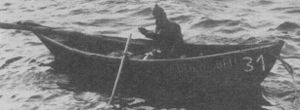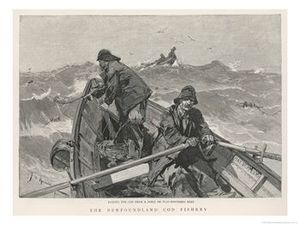Banks dory

The Banks dory, also known as the Grand Banks dory, is a small, open, narrow-flat bottomed, slab-sided boat with a very narrow transom. It was first used for fishing off the Grand Banks of Newfoundland after the 1850's.[1]
The boats were inexpensive to build. They could be stacked or nested inside each other and stored on the decks of larger fishing vessels which functioned as mother ships.
Banks dories have long overhangs at the bow and stern to help them lift over waves. There were one-man and two-man versions. The larger ones (12ft along the bottom or more) could be fitted with sails and a tiller. The dories became more stable in rough weather when they were loaded with about half a ton of catch.
Production
The Banks dory type is very simple and efficient to produce making them well suited to mass production. By 1880, Bank dories were being built principally in the Massachusetts towns of Gloucester, Beverly, Essex, Newburyport, and Salisbury (Amesbury). Other major areas of production included Seabrook, New Hampshire, Lunenburg, Nova Scotia and both Portland and Bremen, Maine. Salisbury alone had 7 shops producing between 200 and 650 boats a year. The firm of Higgins and Giford of Gloucester advertised in 1886 that it had built over 3,000 dories in the preceding 13 years.[2] Founded in 1793, Lowell's Boat Shop of Amesbury Massachusetts is the oldest continuously operating boat shop in United States. It the first to build these boats in any numbers and excelled at their mass production. In the year 1911 Lowell's Boat Shop produced 2029 dories, averaging 7 dories a working day. A National Landmark and working museum, Lowell's Boat Shop continues to build its dories and skiffs in the Lowell tradition to this day.
Mother ships
Banks dories were carried aboard mother ships, usually fishing schooners, and used for handlining cod on the Grand Banks. Prior to the introduction of Banks dories, fish were caught with handlines from the mother ship alone. Weather permitting, the dories were launched early each day with one or two crew and bait from previous catches. During the day they would return several times to the mother ship and unload their catch.
The barquentine, Gazela Primeiro, while not a schooner, was one of the last of the dory mother ships. She had a long association with dories and the Grand Banks cod industry and made her final voyage as late as 1969.
| 30px External images | |
|---|---|
| 16px | The Fog Warning by Winslow Homer |
Banks dories have been capable of surviving long voyages, some unintentional, when the fishermen became separated from their mother ships. One of the more famous adventures was by Howard Blackburn, who survived 5 days in the North Atlantic in January.
A Banks dory is seen in Winslow Homer's painting The Fog Warning.
See also
Notes
References
- Chapelle, Howard L. (1951) American Small Sailing Craft WW Norton Company, New York, ISBN 0-393-03143-8
- Gardner, John (1987) The Dory Book. Mystic Seaport Museum, Mystic Connecticut. ISBN 0-913372-44-7
- Philadelphia Ship Preservation Guild: Gazela Primeiro (1883). Retrieved 23 June 08.
| |||||||||||||||||||
| |||||||||||||||||||||||||||||

